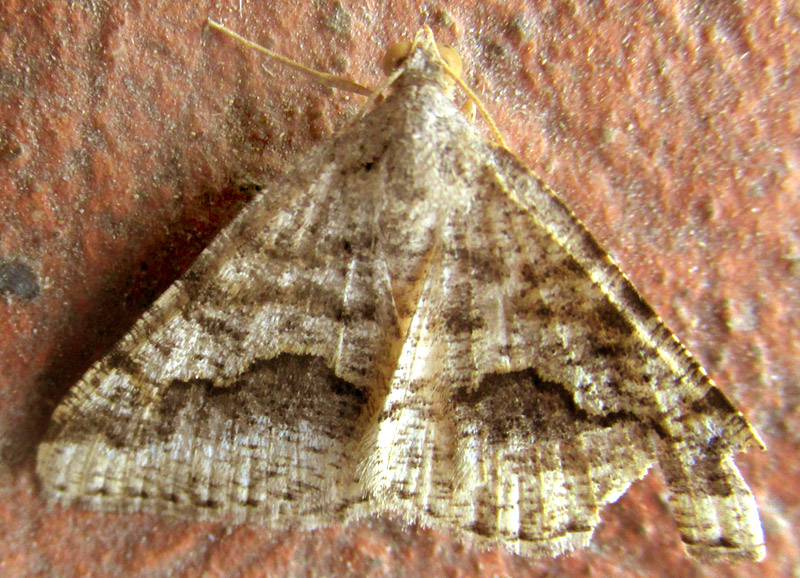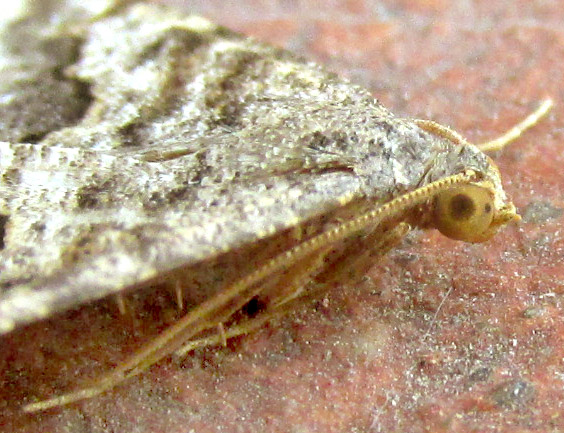Excerpts from Jim Conrad's
Naturalist Newsletter
Entry dated May 17, 2024, issued from near Tequisquiapan; elevation about 1,900m, (6200 ft), ~N20.57°, ~W99.89°; Querétaro state, MÉXICO
ANGLE MOTH

Soon after dawn, beneath a nightlight of a house at the edge of a small village surrounded by mesquite- and acacia-dominated semiarid scrub, the above moth was so chilled, and maybe too exhausted by circling the lamp, that it didn't move as I photographed it.

From the side its antennae was seen as long and slender. In this moth family, the Geometridae, males often bear feathery, or pectinate, antennae while those of females are slender, as seen above. It looks as if the moth has no mouthparts, but I read that geometer moths do have them. The large compound eye seems to show a dark pupil at its center, but that must be a reflective optical effect produced by the compound eye's thousands of hexagonal, lens-containing photoreceptor units called ommatidia.

The moth was so lethargic that with a finger I could lift one wing to provide the view of the undersurface seen above. That perspective also displays the wing's long-hairy inner margin.
The above pictures were sent off to volunteer moth identifier Bea in Ontario, who soon replied that she'd found three very similar species, of which she'd finally settled on SPERANZA COLATA. That moth bears no commonly used English name, though a general name for Speranza species is angle moth.
Speranza colata appears to be commonly occurring from southwestern British Columbia in Canada south though the western US to about the Mexican border. I find no documentation of it occurring in Mexico. However, neither do I find any other well-matching species besides Speranza colata. Among plants, I've identified many temperate North American species doing quite well in Mexico's cool, higher elevations, so finding a Speranza colata here isn't too surprising.
While browsing Internet images of Speranza colata, most individuals were observed to be overall darker than ours; though the blotches and squiggles occupied the same positions, their darkness was more intense and their surface area bled deeper into pale parts. Since pale forms reflect more solar energy while dark ones absorb it, it would seem that our lighter individual is better suited to deal with hotter temperatures associated with global warming than dark forms. However, when the matter was looked into, it proved to be more complex and subtle than that.
An important feature affecting butterfly survivability is its ability to "buffer" the effects of heat. Buffering can be accomplished behaviorally, as by moving between sunlight and shade, or physiologically, as when the body is provided with "shock proteins" enabling physiological processes to withstand high temperatures.
The 2023 study by Esme Ashe-Jepson and others entitled "Tropical butterflies use thermal buffering and thermal tolerance as alternative strategies to cope with temperature increase," found that butterflies with large wings experienced greater thermal buffering than those with smaller wings, so that's bad news for Speranza colata. The researchers also found that darker-winged butterflies could tolerate higher temperatures better than paler-winged ones like our Speranza colata, so that's more bad news.
It would seem that paler-winged lepidopterids would reflect more sunlight energy, thus deal with higher temperatures better. However, the study concluded that, among butterflies, "A trade-off in terms of butterflies’ cooling strategies was observed: those that were good at thermal buffering were less good at thermal tolerance and vice versa."
That paradox is explained like this: Species coping with higher temperatures by having some form of thermal buffering, during the evolution of the species, may have experienced less selective pressure to develop behaviors for dealing with the heat. As the climate becomes warmer and exhibits greater extremes, our pale form's pale wings may absorb less sunlight energy than darker wings, but evolution may not have bestowed the species with adequate "shock proteins," or with behavioral patterns enabling it to deal with excessive heat.
The authors add that in terms of species vulnerability, climate change may be particularly severe in the tropics, where taxa often occupy narrower climate niches, and lower ability to disperse to more suitable places than their temperate counterparts.
With regard to our moth's caterpillar stage, since Speranza colata is a geometer moth -- of which around 23,000 species have been described -- the species' larval forms are known as inchworms, loopers or spanworms. That's because as the caterpillars travel they alternately loop their bodies high in the middle, bringing their front and rear ends close together on the plant surface, then extending the fronts of their bodies to their whole body lengths, and repeating; in such a way they "inch" their way across a leaf.
The "Hostplants and Caterpillars Database" of the Natural History Museum in London, UK, reports that the caterpillars of our moth feed on Purshia gandulosa, the Desert Bitterbush. That bush, a member of the Rose Family, occurs in the southwestern US and Northern Baja California, Mexico, but not here in central Mexico. However, ornamental roses do grow in the backyard where the moth turned up, so maybe that's Rose Family enough for the caterpillars. I can think of no other Rose Family members in this general area.